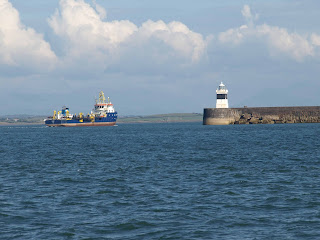Conway seems to be a pleasant sort of place, the old walled city is very picturesque, and not too busy with tourists. We took the train home for a few days, then returned with the car to allow us to explore the area .
The river speed limit sign high and dry at low water.
We drove over to Llandudno and had a walk along the prommenade, the sea front buildings ( mainly hotels and B&B's ) all looked well maintained, and we came away with quite a good impression of the town.
Great Ormes head from Llandudno prommenade.
The view in the opposite direction towards Little Ormes Head.
This is the view from Deganwy Marina towards Conway and the Castle.
The Marina entrance at Deganwy.
The top of the tidal flap gate at low water, the gate is dropped when there is 4m of tide.
Conway castle at low tide with the marina training wall covered in sea weed.
The view towards Penmaemawr, and the Menai Straight from Deganwy beach.
Great Ormes Head from Deganwy beach
A large yacht in the channel with Conway marina in the background.
The marina dredger 'Little Orme' moored on the pontoon.
On 8th August we decided to have a night at anchor and re-visit the East coast of Angelsey. At 14:50 we anchored in Red Wharfe Bay, just North of Puffin sound. After a fairly rolly night at anchor we had a look at the area of moorings at Red Wharfe village, using the keel as a 'dip stick' at times.
The entrance channel to Red Wharfe Village.
From here we motored over to Moelfre again for lunch, anchoring in the same place as on our trip down to Conway previously.
On the way back to Conway we raised our big G2 Genneker ( you can see the reflection of the sail in my sunglasses ! ) but the wind soon faded out, and we ended up motoring back to the marina.
We have pretty well decided to leave 'NJ' in Deganwy for the winter, as it is not much further than Fleetwood in terms of travel time, and there are quite a few places to visit in the area.






















































